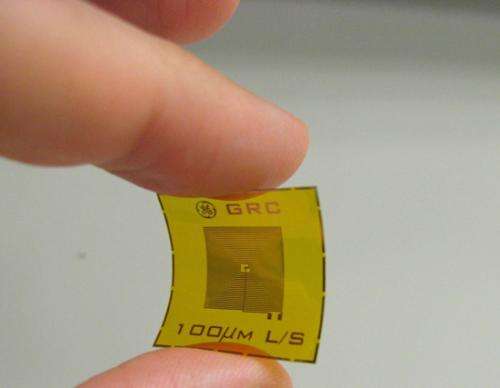February 17, 2015 weblog
GE Global Research works on RFID tag for detecting explosives

Tech sites are talking about an explosives detector the size of a postage stamp. This is a wireless RFID (radio-frequency identification) sensor tag, battery-free. The tags are specially capable of chemical sensing. The company behind the tags is GE Global Research (the technology development arm of GE) in partnership with an inter-agency task force focused on anti-terrorism, the Technical Support Working Group (TSWG), Quantum Magnetics, and with assistance of KemSENSE. The detection solution has numerous advantages, in cost, size and versatility. GE Global Research expects production costs for these sensors would range from 5 to 50 cents per sensor, depending on performance specs and fabrication volume. GE Global Research said the tags can be deployed on a variety of surfaces.
The headline for its news release earlier this month honed in on use at shipping ports: "Advanced Explosive and Chemical Threat Detection at Shipping Ports" and the tags can be deployed anywhere cargo containers are used, such as rail centers, seaports, or airports. The sensor could be placed as a sticker inside of a cargo container on a ship or on packaging for shipped goods. In airport settings they could be used as part of a fixed or mobile security solution. GE Reports said the new sensor, which should cost a few cents to produce, was far smaller and consumed far less power than desktop detectors found at airports and other inspection areas.
The RFID tag development may present advantages over some machines today. "In airports today, bulky, stationary desktop systems typically screen for explosives," said Radislav Potyrailo, a principal scientist at GE Global Research who worked on the project. "Suspicious surfaces are swabbed and separately analyzed, consuming substantial time, space and power. Compared to a conventional desktop detector, our system is 300 times smaller, and reduces weight and power use 100 fold. To achieve needed accuracy, GE's approach simplifies detection by using an individual sensor rather than relying on arrays of multiple sensors." In GE Reports, he said, "It's a stick-it-and-forget-it kind of thing. This advance brings us closer to a future of ubiquitous testing of chemical explosives."
The detector is made of two parts: the RFID sensor tag and a battery-powered, cellphone-size handheld tag reader. The news release discussed how it works. "If placed on the outside of a shipping container, for example, and the presence of a dangerous explosive or oxidizer is detected in the air, the sensing material will change its electronic properties and will trigger the RFID tag to send an alert to a cell phone-sized reader."
GE Reports said the tag has a coiled antenna attached to a microchip in the center. The antenna harvests power from the reader when it is nearby. Special film is layered on top of the antenna and chip. The film and sensor combination responds to molecules or particles of explosives or oxidizers that are used for making improvised bombs. GE Reports said, "The portable reader is hitting the tag with radio frequencies, just like light hitting the butterfly's wing. When workers hold it up to the sensor tag, the radio frequency spectrum is predictably altered by the presence of hazardous materials trapped in the film. This radio spectrum response is picked up by the antenna and then transmitted back to the reader, which processes the data to let authorities know whether a dangerous substance is present and how much of it is around." The chemical detection film was designed by scientists pooling knowledge of materials science, nanotechnology, chemistry and data analytics.
Potyrailo said in GE Reports that the technology's sensing range will expand into an assortment of applications in the future, including passive gas leaks, electrical insulation degradation and bacterial contamination detection.
More information: www.geglobalresearch.com/news/ … ction-shipping-ports
© 2015 Tech Xplore














